
Nabadwip, also spelt Navadwip, anciently Nadia or Nudiya, is a heritage city in Nadia district in the Indian state of West Bengal. It is regarded as a holy place by Hindus, and is the birthplace of Chaitanya Mahaprabhu. Famous for Rass festival where city is illuminated with lights, deities of God and goddesses are made on each corner of Nabadwip town. Hundreds of people gather to this small town on the occasion of raas utsab. Located on the western bank of the Hooghly River, it is considered to have been founded in 1063 CE, and served as the old capital of the Sena dynasty. A center of learning and philosophy in medieval India, the city is still noted for its traditional Sanskrit schools. The Navya Nyaya school of logic reached its peak with the efforts of some well known contemporary philosophers of Nabadwip. The great Vaishnava saint, social reformer and an important figure of the Bhakti movement, Chaitanya Mahaprabhu (1486–1534) was born here. It was after Chaitanya Mahaprabhu's birth that Nabadwip became an important center of pilgrimage for the Vaishnavas worldwide as well as for Hindus in general. Many who follow Gaudiya Vaishnavism visit Nabadwip to celebrate the auspicious birthday day of Shri Mahaprabhu, which, as per lunar calculations, occurs on Phalguni Purnima. This day is commonly known as Gaura-purnima. Aside from this, Nabadwip is visited for various other festivals like Dol Jatra and Rash purnima.
Gokulchandra Nag, was a Bengali writer and artist, best known as one of the founding members of the Kallol literary group and circle during early twentieth century Bengal' His elder brother Kalidas Nag was a distinguished historian and academician.

The Indigo revolt was a peasant movement and subsequent uprising of indigo farmers against the indigo planters, that arose in Bengal in 1859, and continued for over a year. The village headmen (Mandals) and substantial ryots were the most active and numerous groups who led the peasants. Sometimes disgruntled former employees of European planters - 'gomashta' or 'diwan' of the Indigo factories, took the lead to mobilise the peasants against the Indigo planters.
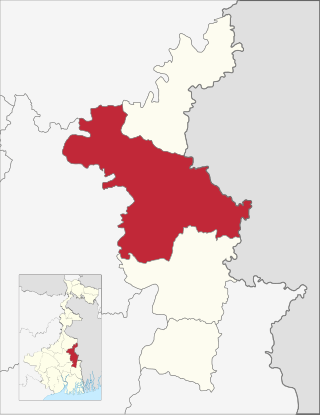
Krishnanagar Sadar subdivision is an administrative subdivision of Nadia district in the state of West Bengal, India.

Patachitra or Pattachitra is a general term for traditional, cloth-based scroll painting, based in the eastern Indian states of Odisha, West Bengal and parts of Bangladesh. Patachitra artform is known for its intricate details as well as mythological narratives and folktales inscribed in it. Pattachitra is one of the ancient artworks of Odisha, originally created for ritual use and as souvenirs for pilgrims to Puri, as well as other temples in Odisha. Patachitras are a component of an ancient Bengali narrative art, originally serving as a visual device during the performance of a song.

Durga Mohan Bhattacharyya was an Indian scholar of Sanskrit. He had served as a professor of Sanskrit at the Scottish Church College in Calcutta.
Krishnananda Agamavagish was a noted Kulin Bengali Brahmin of Nabadwip, Nadia district origin and a renowned Pandita (Scholar) and Sadhaka of Tantra tradition who lived around 1575 CE. He is the author of the Tantrasara.
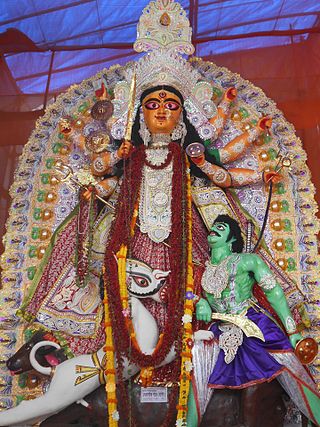
Shakto Raas is the most celebrated festival of Nabadwip, Shantipur and Krishnanagar of Nadia district in West Bengal, India. This festival is celebrated thirty-five days after the autumnal Durga Puja celebration, fifteen days after Kali Puja and a week after Jagaddhatri Puja in Kartik Purnima. To the people of Nabadwip, Rash Festival is everything. The entire Hindu community eagerly waits for this festival all the year round.
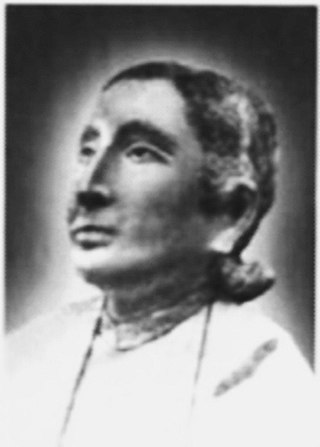
Rangalal Bandyopadhyay was a Bengali poet, journalist, and author.
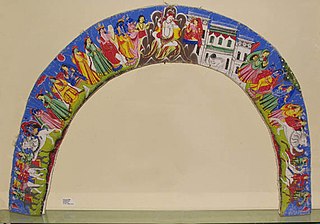
Chalchitra is a part of Bengal Patachitra. It referred to the Debi Chal or Durga chala, the background of the Durga Pratima or idol. Originally, these were used to give a proper proportion to the structure. This tradition is very ancient and is still maintained.

The Indian state, West Bengal has a rich cultural heritage. Due to the reign of many different rulers in the past, arts and crafts in West Bengal underwent many changes giving an artistic diversity today in the forms of traditional handicrafts, terracotta, painting and carving, dances and music.
Bidhushekhar Shastri (1878–1957) was a Bengali Sanskrit scholar, editor and linguist.
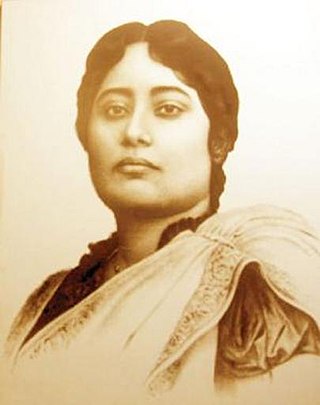
Mrinalini Devi was a translator and the wife of Nobel laureate poet, philosopher, author and musician Rabindranath Tagore. She was from the Jessore district, where her father worked at the Tagore estate. In 1883, at the age of nine, she married Tagore.

Nabadwip State General Hospital is the main hospital in Nabadwip. It is the Government hospital of West Bengal, founded in 1897. It was formerly known as the Garrett Hospital. Blood bank service has been started here since 2015.
Prasanna Chandra Tarkaratna was an Indian philosopher, scholar and logician. He was one of the best tol scholars of Nabadwip in the early 19th century. Prasanna Chandra was the student of Goloknath Nayaratna.

Uddharan Dutta Takur (উদ্ধারণ দত্ত ঠাকুর) was an Indian philosopher and saint from the Gaudiya Vaishnava school of Vedanta tradition, producing a great number of philosophical works on the theology and practice of Bhakti yoga, Vaishnava Vedanta and associated disciplines. He is known as one of the Dwadasha gopas,.
Sandhyarani Chatterjee was an Indian actress who is known for her work in Bengali cinema. She was a reigning actress of Bengali cinema during 1940s and 1950s. She appeared in more than 250 Bengali films. She made her silver screen debut in Sarbojanin Bibahotsab. She featured opposite Uttam Kumar in Ajoy Kar's Bardidi (1957). Even after she played supporting characters later, her popularity remained intact.

Anjana is a local river of Nadia district of West Bengal. The 29 km (18 mi) long river drains Krishnanagar, Jalalkhali and Badkulla areas, which belong to Krishnanagar, and Krishnanagar 1 and Hanshkhali community development block. The Anjana River originates on the southern bank of the Jalangi River at the northern end of Krishnanagar, the river generally flows south through the Jalalkhali area before reaching Badkulla. Passing the town of Badkulla, the river flows southeast and joins the Churni river. A tributary originates from this river at Hat Boalia, which joins the Churni river at Hanshkhali.














